Third Part of a Three-Part Series
I. The Nano-Future and the High Frontier
In Part One of this series, we noted that the U.S., in the course of its history, has had to fight just about every other major power on the planet. Yes, indeed, the world is competitive and dangerous, and so military technology is always a key component of a nation’s survival equation.
In Part Two of this series, we focused on two central elements of military and economic competition: the nano-world of cyberspace and the vastness of outer space. We recalled that in both realms of space—the infinitely small and the infinitely large—the United States initially took the lead, and yet, since then, that lead has shrunk, even disappeared. And our most potent competitor, of course, is China.
Now, starting with cyberspace, we can observe that computer hacking is one of the greatest dangers we confront: While hacking seems to be a worldwide phenomenon, Americans can still marvel, in particular, at the fact that Chinese warplanes look exactly like the U.S. warplanes built a a few years before. Meanwhile, Chinese drones copycat U.S. drones.
Although the Trump administration, as recently as May 11, has taken solid steps to upgrade cyber-security, it’s not certain that current efforts will prove sufficient to stop China’s systematized e-espionage.
To put that another way, if the Chinese government—as well as other governments, such as Russia—has turned military and industrial hacking into a national strategy, then we must make cyber-defense our national strategy.
II. A Cyber-Academy?
To that end, two Navy veterans have suggested a U.S. “cyber academy,”modeled after Annapolis and the other service academies. As Mark Hagerott, now chancellor of the North Dakota University System, and James Stavridis, a retired four-star admiral and former supreme commander of NATO’s armed forces, wrote in March, “The Pentagon should . . . establish a national cyber academy to defend America in cyberspace, in our critical infrastructure, and in the internet of things.”
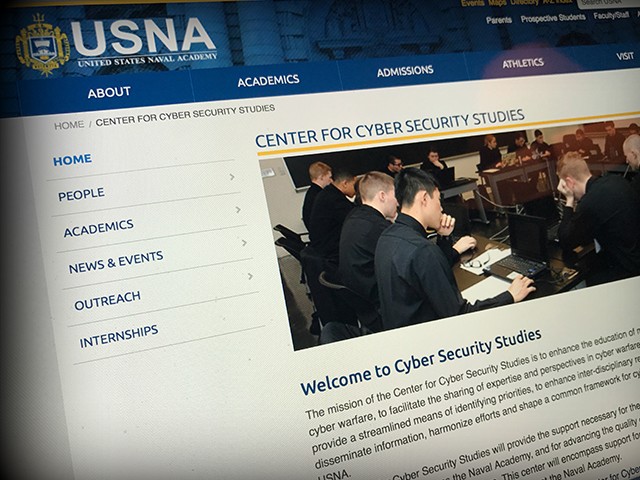
Hagerott and Stavridis make a shrewd point about the reality of organizational behavior: Yes, it’s true that today, all the branches of the military understand that cyber-security, and cyber-combat, are important, and yet at the same time, it’s unlikely that cyber anything will ever be at the core of any branch’s mission. That is, the Navy will always be mostly about ships, the Marines will always focus on mobile infantry, and so on. Thus cyber will inevitably be secondary to each branch—and yet down the road somewhere, that could be disastrous.
The best solution, Hagerott and Stavridis argue, is to make cyber its own independent thing: That is, a robust career path within the military, such that a young up-and-comer in the military could see cyber as just as promising as any other specialty.
As an aside, we can recall that in the past, the U.S. military made similarly profound organizational adaptations as it sought to maximize the use of new technology. For example, after the Wright Brothers flew their first flight in 1903, the War Department initially thought of aviation as a reconnaissance tool, and so flyers were folded into the Aeronautical Division of the Army’s Signal Corps.
Yet as the years, and the wars, went by, it became evident that airplanes were most valuable as direct combat weapons, and so the organization hub of Army aviation evolved to reflect that shift: it became the Army Air Corps, then the Army Air Force.
However, the organizational and doctrinal problems that came from lumping aviation in the same branch with, say, armor, were glaring. And so finally, in 1947, Congress established an entirely separate branch of the armed services: the U.S. Air Force.
Now today, Hagerott and Stavridis argue, it’s time for another moment of organizational evolution, this time on behalf of cyber-strength. And as we have seen, while the technology of cyber is revised with each new moment, the two cyber-academy advocates have the wisdom of military history on their side.
III. The Ultimate High Ground
So now let’s turn our attention to the other kind of space—outer space. It’s long been understood that space is a vital strategic domain, although no one put the stakes in starker terms than Sen. Lyndon B. Johnson (D-TX), speaking in 1958:
Control of space means control of the world, far more certainly, far more totally, than any control that has ever been or ever could be achieved by weapons or by troops of occupation. The race we are in—or which we must enter—is not the race to perfect long-range ballistic missiles. There is something more important than any ultimate weapon. That is the ultimate position—the position of total control over Earth that lies somewhere out in space. This is the future, the distant future, though not so distant as we may have thought. Whoever gains that ultimate position gains control, total control, over the Earth, for the purposes of tyranny or for the service of freedom.
At the time, Johnson was the Senate’s Majority Leader, and as such, he was the driving force in Congress behind the creation of the National Aeronautics and Space Administration (NASA); he later, of course, became our 35th president.
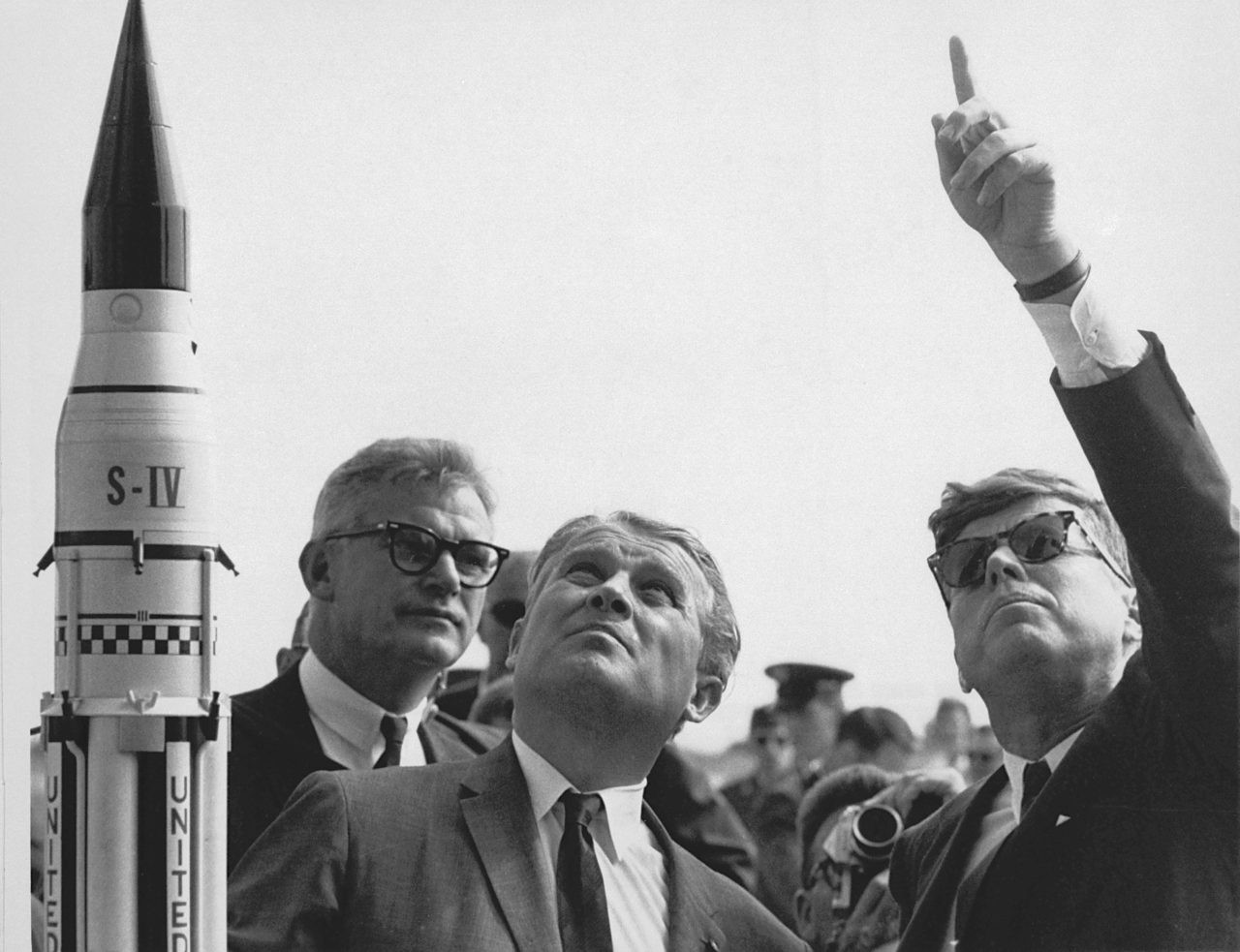
Dr. Wernher von Braun explains the Saturn Launch System to President John F. Kennedy. (Source: NASA on The Commons/Flickr)
The point that Johnson was making, six decades ago, was remarkably forward-looking, and, well, upward looking: Space will prove to be the decisive dimension. As we all know, throughout military history, the higher position has usually been the superior position.
To cite a specific ‘frinstance, we can think of North Korea. Right now, it’s ridiculous that a country of only 25 million people, with but a tiny economy, is nevertheless to be rated as a serious threat to the U.S. homeland. That is, it’s not at all certain that we have the capacity to shoot down a possible North Korean nuclear missile aimed at Alaska, Hawaii, or the Pacific Northwest. Indeed, if the Pyongyang regime continues to improve its offensive capabilities faster than we improve our defensive capabilities, it’s only a matter of time before Kim Jong Un’s little dictatorship can threaten the entire continental U.S.
Obviously, past presidents have been careless about dealing with this threat, and just as obviously, we must immediately upgrade our missile-defense capabilities, especially since, over time, more countries will develop the same WMD capability.
To be sure, there are lots of ways that we might stymie the North Korean threat, but one way would be to develop a reliable “look down” capability. That is, post U.S. missile-defense satellites permanently overhead, in geostationary orbit.
Once again, it’s the high “ground” that could make the difference. If Kim looks up and sees, in effect, Uncle Sam’s eye looking down at him, that could prove to be the overwhelming deterrence that we need.
We can observe that such a defensive satellite system would be a powerful application of the “High Frontier” concept outlined decades ago by an Air Force visionary, Gen. Daniel O. Graham. That concept was later embraced by President Ronald Reagan when he launched his Strategic Defense Initiative in 1983; SDI, we might recall, proved to be the ultimate game-changer of the Cold War.
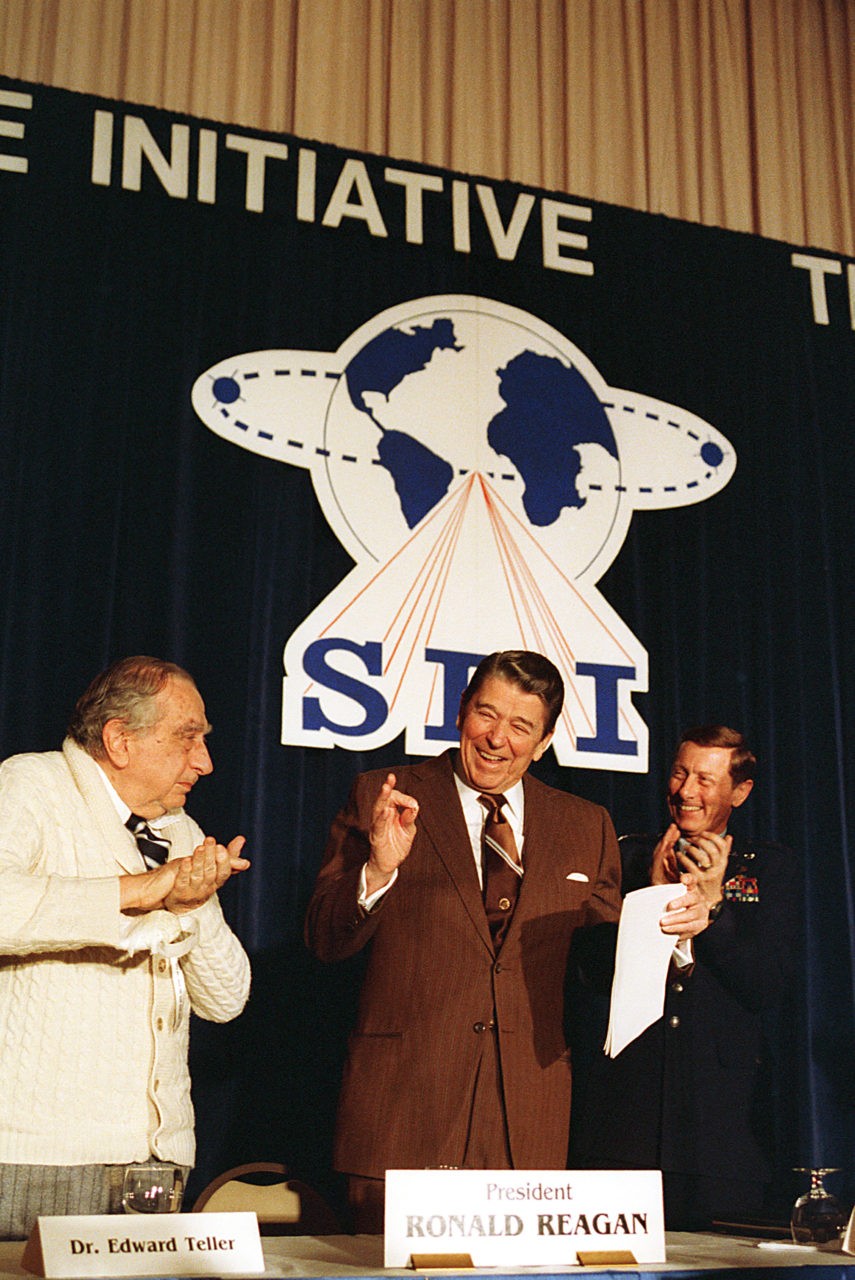
President Ronald Reagan is flanked by physicist Dr. Edward Teller, left, and Lt. Gen. James A. Abrahamson, director of Strategic Defense Initiative, as he arrives to address a conference marking the first five years of his missile defense program in Washinton, D.C., Monday, March 14, 1988. (AP Photo/Charles Tasnadi)
Yet in the decades since, some American presidents have gotten the strange idea that American security is better secured by attempting to spread democracy, by force, to hostile Muslim countries, or by supporting world-wide crusades against climate change. Thus missile defense—which could save millions of Americans from being nuked—has been neglected. Sad!
In the meantime, the Air Force, operating all these years within restrictive political encumbrances, has done its best to stay focused on strategic concerns. On May 7, for example, the USAF’s X-37B, an unmanned “mini-shuttle,” cruised to a soft landing at Florida’s Kennedy Space Center. It had been in orbit for 718 days. What, exactly, was the spacecraft doing up there for those two years? That’s classified. To which the rest of us ought to say: “Good! Let’s keep other countries guessing!”
Yet at the same time, potential foes are operating, too, in space. Back in 2007, the Chinese successfully destroyed a satellite (one of their own) in orbital space. The implication was clear: In addition to the United States, the People’s Republic of China had developed the capacity to wage active kinetic astro-war.
We must conclude: Given that the security of the U.S., as well as its economy, is heavily dependent on our satellites, this Chinese capability is no small matter. (The Russians, and undoubtedly other countries, also have the same sort of arsenal.)
Thus we can see that space is being increasingly militarized, and not just by the U.S. That is, many of the great powers of the earth are grasping for the even greater power that comes to those who can operate extra-terrestrially.
We can also conclude, moreover, that this stern international reality casts a long shadow over the efforts by various billionaires to turn space into their own privately profitable wonderland. That is, it’s cool that Elon Musk, Jeff Bezos, Richard Branson, Paul Allen, and other tech tycoons have ambitious plans for high-priced space joyrides, asteroid mining, and even deep space travel. It’s even cooler that some of them have already developed powerful new technologies, such as reusable rocket launchers.
Yet all that money, and all that glamor, won’t change the reality that private space activity is inherently vulnerable to the actions of other country’s public sectors—specifically, their militaries. And did I mention the possibility of space vandals, or even space pirates?
It seems evident that the same sort of system that keeps order on the land and on the sea will also be needed to keep order in space: That is, police and, if needed, the military, all guided by the rule of law.
At an April 4 space symposium in Colorado, USAF Lt. Col. Thomas Schilling outlined the case for extending Uncle Sam’s protective reach into space:
The [U.S.] Navy secures the freedom of action for commerce globally for the good of all humankind, and I think it’s going to take a force very similar to that to provide the predictability and security that the marketplace of space will need. I think that would be the role of the United States Air Force moving into the future.
Moreover, on May 12, NASA announced plans to return humans to the moon in 2027 and then to land humans on Mars by the mid-2030s. This will be more than great news—it will be epic news. If, that is, it happens: after all, plenty of earlier deadlines have been missed.
And if it doesn’t happen—that is, if the U.S. loses its nerve once again—then we can only wonder what will become of space. If space is left up for grabs, then most likely, some other nation-state will end up grabbing space. As one might say, political nature abhors a political vacuum.
That is, the Chinese, the Russians—or conceivably, some James Bond-movie-type villain—will have the power to extract taxes, tribute, or ransom, from privatized spacegoers. None of that would work out well for America, or Americans.
This potential reality—that China or some other rival, could end up in charge of the ultimate commanding heights—became clear on April 26, at a Capitol Hill hearing convened by Sen. Ted Cruz, chairman of the Subcommittee on Space, Science, and Competitiveness. Cruz was eager to highlight, as he put it, “the real possibility that in the not too distant future, American private citizens will be able to reach space from a launch pad or a runway in Texas.” Cruz is right; such capitalist exuberance is, in fact, a real possibility—and it would, indeed, be wonderful.
However, as one of the witnesses at Cruz’s hearing, Robert Bigelow—founder of an aerospace company that’s working to develop private space stations—pointed out, private visionaries will always need government protection. That is, no individual is rich enough to buy space-mercenaries, and besides, history tells us that such hired guns aren’t very reliable.
Bigelow further observed that China has displayed an “ownership-minded” approach to matters down on earth, such as the disputes over islands in the South China Sea. Indeed, he continued, China seems to be taking the same approach toward future permanent lunar settlements. As he put it, if China were to claim territory on the moon, it would have an “amazing impact” on China’s power and prestige down here in this world.
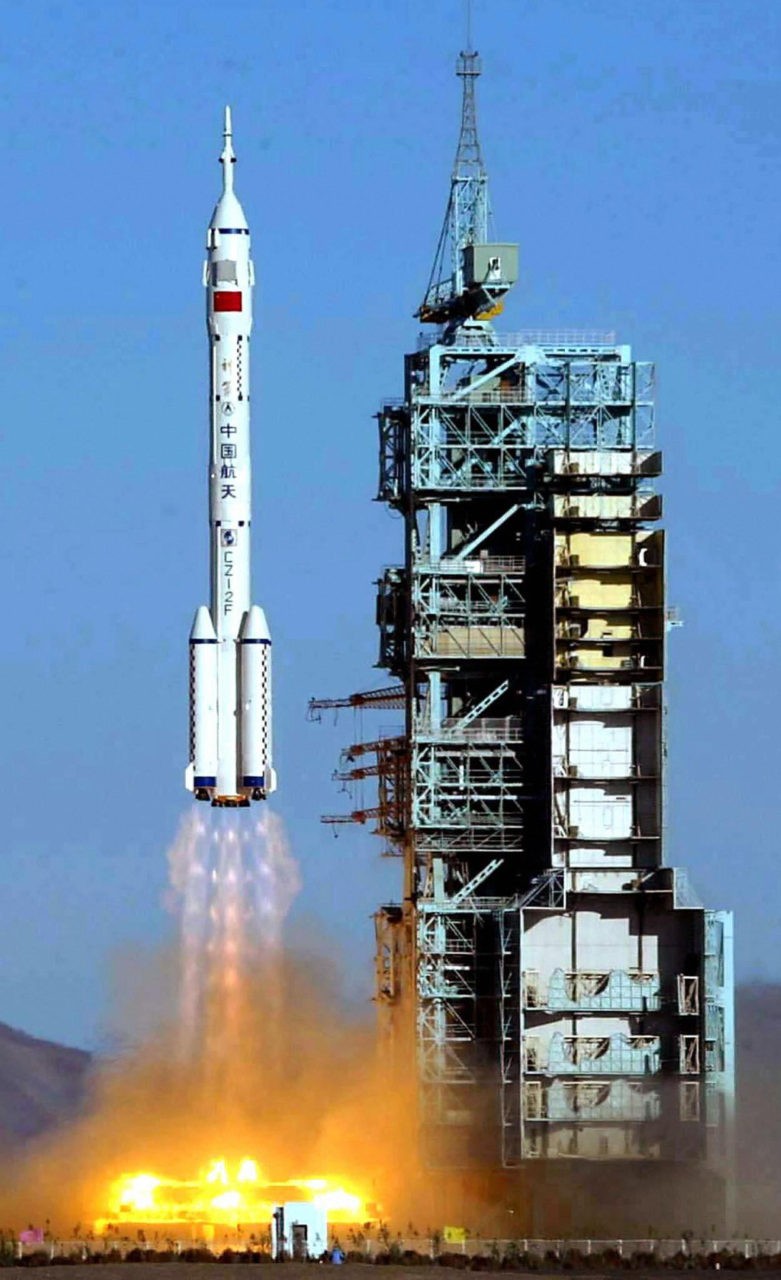
A Long March CZ-2F rocket carrying the manned craft ‘Shenzhou V’ being launched into space from the Jiuquan launch center in China, October 15, 2003. (Photo: AFP/AFP/Getty Images)
Indeed, as we noted in Part One, the Chinese are acutely aware that five or six centuries ago, they let their massive head-start in expansionary technology—sailing ship and gunpowder—slip through their fingers. Now today, they don’t intend to make that mistake again. “I don’t think it’s a joke,” Bigelow declared of China’s beyond-this-world ambitions. “I don’t think it’s something to be cavalier about.”
Bigelow is correct: China’s quest for aggrandizement is not something to be cavalier about. On the other hand, it’s also not something to be paranoid about. That is, China is doing today what every great civilization has typically done—it is striving to be greater. And there’s nothing wrong with that, or, at least, there’s nothing we can do to change that sort of big-think. All we can do is resolve to defend ourselves, no matter what, while prudently but determinedly pursuing our own interests—everywhere. Yes, we, too, should think big.
Finally, it could even be possible that we could work with China, or Russia, or other countries, as we all go space-voyaging, perhaps as a team. We can note that such multi-ethnic—as opposed to multicultural—cooperation worked on Star Trek. Admittedly, that was a work of fiction, but nevertheless, it offers something precious: hope.
Hope, that is, for a better future, here on earth, and out amidst the stars. And so even if the U.S. must do it all by itself, in competition with those other states, it’s a hope always worth striving for.
IV. To Boldly Go Where No Man Has Gone Before
Many of us know the opening narration of Star Trek by heart, starting with, “Space, the final frontier.” The narrator, of course, was William Shatner, playing Captain Kirk, commander of the starship USS Enterprise. The show debuted on NBC in 1966, and it lives, seemingly forever, in reruns. Moreover, other incarnations carry on, too, in movies, books, videogames—there’s even a brand-new TV show.
Without a doubt, the original Star Trek captured something in the political culture of the 60s, as well as in the popular culture. Indeed, Kirk was modeled after President John F. Kennedy, down to his handsome face, his luxuriant hair, and his lusty ways.
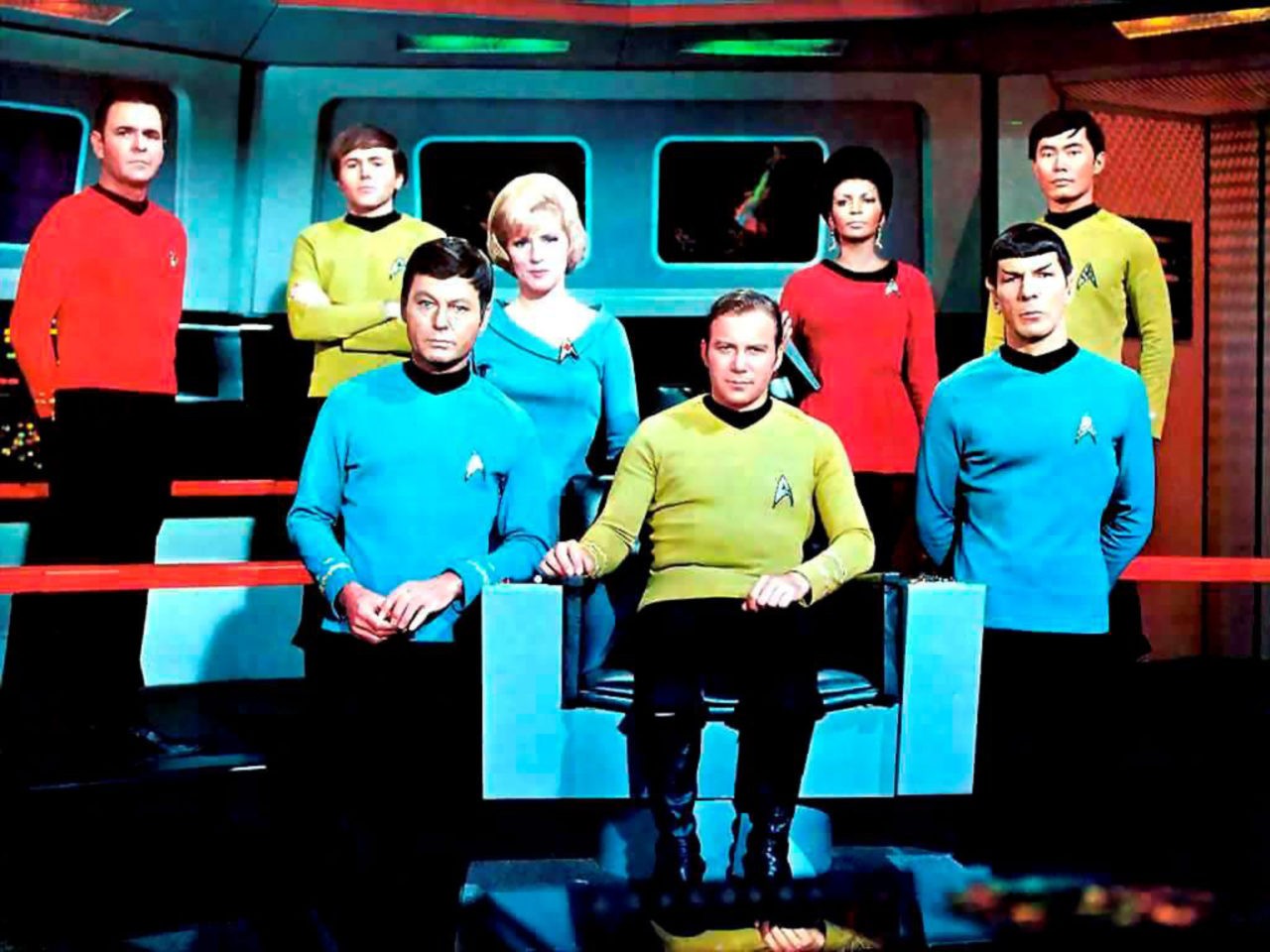
Promotional photo of the cast of “Star Trek” during the show’s third season (1968-1969).
And yet the real-life JFK was far more than a dreamboat. He was a determined political leader, eager to make his mark in history; the manned space program was his signature presidential endeavor.
It was the 35th president who convened a special joint session of Congress on May 25, 1961, in large part to make the case for space. There, in the Capitol, he issued his famous “moon shot” pledge. “Before this decade is out,” he declared, America will achieve the goal “landing a man on the moon and returning him safely to the earth.”
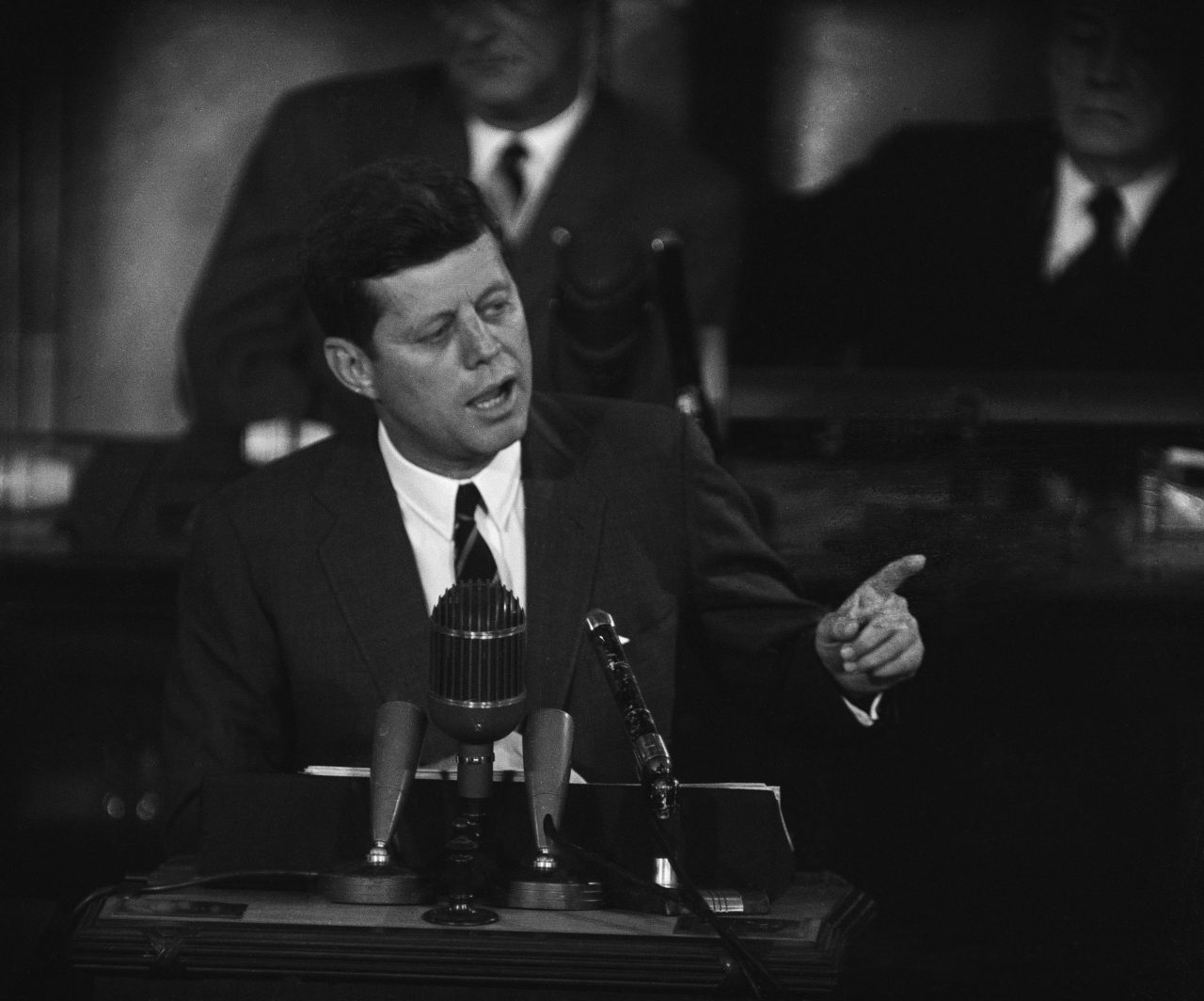
President John F. Kennedy’s address before a joint session of Congress on May 25, 1961, issuing his famous “moon shot pledge.” (AP Photo)
As we know, Kennedy was assassinated two years later, and yet his dream lived on—and not just in a fictional TV show. In 1969, we did, in fact, land a man on the moon—two, actually. And we brought them both back, and then, over the next three years, sent another ten.

President John F. Kennedy delivering his famous speech at Rice University Stadium in Houston, Texas, September 12, 1962, where he declared: “We choose to go to the Moon, and do the other things, not because they are easy, but because they are hard.” (Source: NASA on The Commons/Flickr)
Yet then the culture changed, and with it, politics. The original Star Trek went off the air, and the space program shriveled. In Part One of this series, we compared the recent U.S. retreat from space exploration to China’s decision to withdraw from oceanic exploration six hundred years ago; that was one of the most calamitous moments in Chinese history. And in Part Two, we further considered outer space in the context of current international rivalries.
Now we can add: If the strategic and geopolitical aspects of exploration are compelling, so are the cultural and historical aspects. After all, as the founder of this website, the late Andrew Breitbart, liked to say, “Politics is downstream from culture.” That is, what people think and feel—for better or for worse—has a way of manifesting itself in political action.
And the urge to explore is not only cultural, it’s primal. It is based, ultimately, on a powerful human impulse: curiosity. That impulse, writ large, leads to great historical events.
Nobody ever articulated this point better than Alfred Lord Tennyson, author of the famous poem, “Ulysses.” In that lyrical work, first published in 1842, Tennyson summons up the mythical hero of the Trojan War (also known as Odysseus), by now in his old age. He is back home in his kingdom, having survived the 20 years of warring and adventuring described in The Iliad and The Odyssey.
Yet even now, in his advancing years, the aged king feels the urge to once again go a-roving. As he puts it, “Some work of noble note, may yet be done/ Not unbecoming men that strove with Gods.” And so, he continues, his purpose is “To sail beyond the sunset, and the baths/ Of all the western stars, until I die.” The poem closes with ringing words of resolve that have ennobled so many speeches, including political speeches: “To strive, to seek, to find, and not to yield.”
Okay, so now let’s transfer this point from the imagined world of epic poetry to the actual world of epic deeds. Once again, it’s the trailblazers who are remembered.
V. Living in History—Forever
To illustrate, we might consider: What if the average American was asked the question, “What’s the most important historical event that occurred in the 1400s?” Chances are, most folks would instantly say, “1492.”

Posthumous portrait of Christopher Columbus by Sebastiano del Piombo, 1519. (Source: Wikimedia Commons)
That, of course, was the year that Christopher Columbus first made landfall in the Americas. In other words, all the kings and popes of that century, and all the painters and conquerors, seem less significant than that redoubtable explorer, sailing three 50-foot-long ships across the Atlantic. Thus a lesson for those who thirst for eternal glory: If you want to be remembered, discover something.
To further underscore this point, we might consider the career of another 15th century explorer, Infante Dom Henrique, known to history as Henry the Navigator. Born in Portugal in 1394, Prince Henry never ascended to the throne in Lisbon, but he is far better remembered than any Portuguese monarch of that era.
In those days, Portugal was just a tiny country on the edge of Europe, still recovering from 500 years of subjugation by Muslim invaders, and frequently at war with its larger neighbor on the Iberian peninsula, Spain. So there was no particular reason to think that Henry, or his country, would prove to be consequential in the course of history. As one of Henry’s most recent biographers, Sir Peter Russell of Oxford University, wrote in 2001:
The Portuguese world into which the Prince was born exhibited no features that could have caused anyone to suppose that, forty years on, Portugal would become Europe’s first maritime empire.
Yet even as a young man, Henry had a sense of purpose; when he was old enough, he chose as his personal motto talant de bien fere—“a hunger to perform worthy deeds.” Then Henry set about looking for ways to live up to his own words.
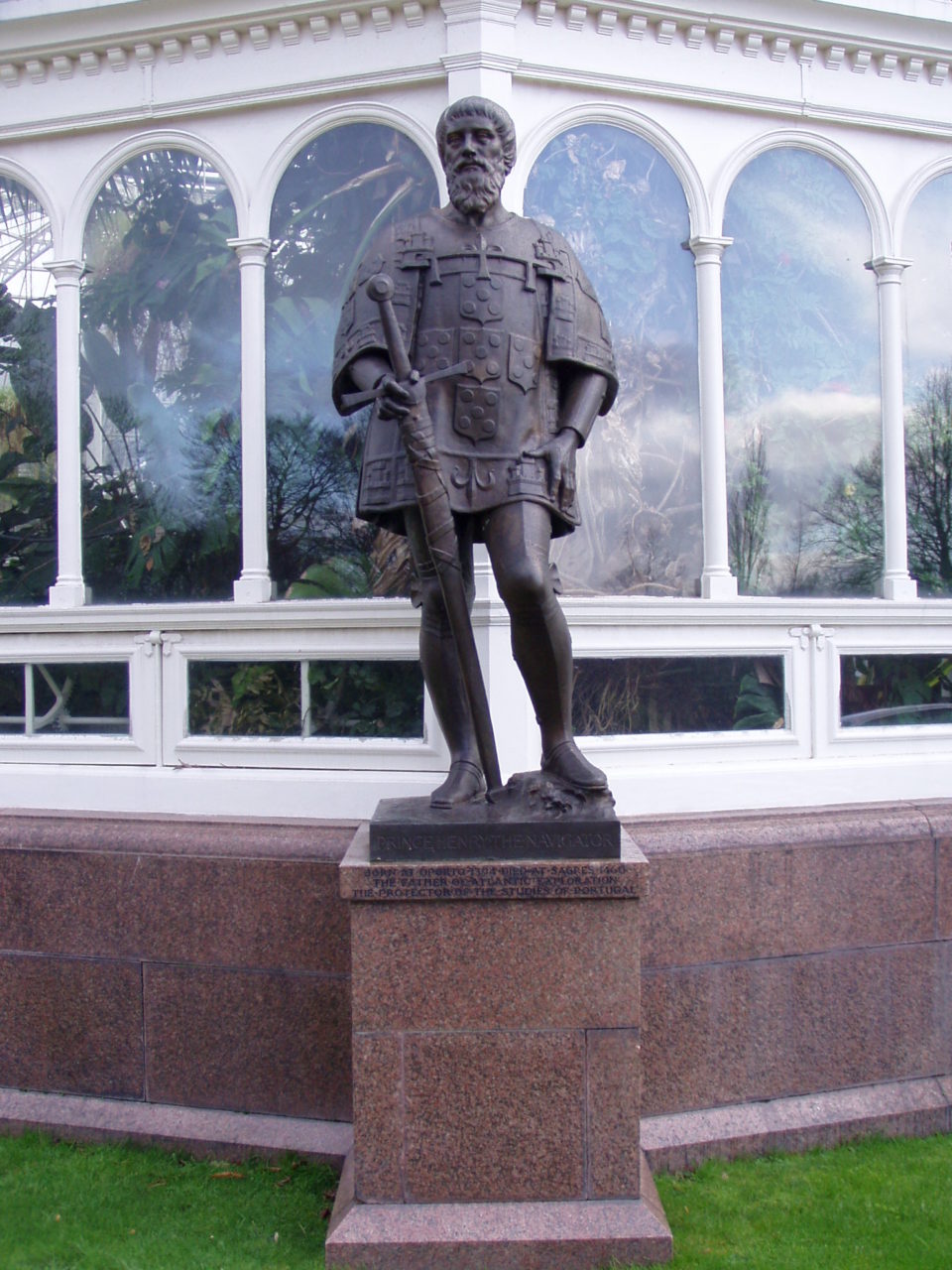
Statue of Henry the Navigator, in bronze by Léon-Joseph Chavalliaud (1899), outside the Palm House at Sefton Park, Liverpool. (Source: Wikimedia Commons)
One of the hoped-for deeds of that era was the quest to reach India and China. Why? For purposes of world-historical glory, of course, but also, crucially, for commercial profits. That is, ever since Marco Polo had returned to Italy in the late 13th century, full of tales about the wondrous riches of the Orient, other Europeans were determined to follow in his footsteps—or, better yet, to get to the Far East by sea.
Thus it was his far-reaching seafaring that became the great work of Henry’s life. And here he was helped, as successful explorers often are, by new technology. The high tech of the 15th century was a new kind of sailing ship, the caravel, which sported two or three masts with triangular sails; these vessels were far more maneuverable than traditional square-riggers.
Led by Henry in the 1420s, the newly nimble Portuguese navy soon occupied the Atlantic islands of Madeira and the Azores. And new riches came back home: fish, sugar, wheat, as well as other precious commodities, such as “dragon’s blood,” the resin from the dragon tree (Dracaena draco), used as both a dye and a medicine.
Meanwhile, other of Henry’s caravels traveled down the western shores of Africa—the so-called Guinea Coast. It was there that Portugal began the slave trade; the first human cargo of Moors came back to Lisbon in 1444.
Today, of course, everybody rightly joins in condemnation of slavery, but in Henry’s day it was a standard practice, even more so in Africa than in Europe. In fact, the Portuguese—and later European oceanic slave traders—typically purchased slaves from land-based African or Arab slave traders. Of course, two wrongs don’t make a right, and yet still, blame for the brutality must be appropriately apportioned; the West had no monopoly on this evil.
In the meantime, the Portuguese were by now getting good at globetrotting. Even after Henry’s death in 1460, Portugal pushed on. His grand strategy continued to unfold, as Portuguese mariners found fantastic wealth (and also fantastically high mortality rates) as they planted their banners at the mouth of the Congo River (1482) and in South Africa (1486), India (1498), Brazil (1500), Indonesia (1511), the Persian Gulf (1515), and China (1557). Thus did plenteous commercial profits stream back to the mother country.
So we can see how the tiny country of Portugal emerged, at least for a time, as a superpower. Unfortunately for the nation, though, neighboring Spain, a vastly greater land power, was getting the same idea: It was Madrid, not Lisbon, that sent Columbus to America. And so soon, Spain came, in fact, to dominate Portugal.

“Landing of Columbus,” painting by John Vanderlyn, 1846. Christopher Columbus is depicted landing in the West Indies, on an island that the natives called Guanahani and he named San Salvador, on October 12, 1492. He raises the royal banner, claiming the land for his Spanish patrons. (Source: Wikimedia Commons)
We might pause to note that an excellent overview of this pivotal era can be found in a 2003 work from the late historian Hugh Thomas: Rivers of Gold: The Rise of the Spanish Empire, from Columbus to Magellan. The title communicates one key aspect of Spain’s desire to subdue the Americas, as does Thomas’ comment that the Spaniards were also driven by a “desire for . . . glory, to cut some kind of dash in the world.” In other words, there’s always a yearning to leave a mark, and one way to accomplish that is “to boldly go where no man has gone before”—once again quoting Captain Kirk.
Still, Portugal’s power lives on in the form of the Portuguese-speaking country of Brazil, population 207 million, which might yet prove to be a superpower. And within Portuguese culture, Henry is regarded as a national hero. (Meanwhile, here in the U.S., Christopher Columbus has the honor of having his own federal holiday.)
Okay, so that’s enough on Henry and Columbus. And yet many centuries after their deaths, they and their peers in the explorer/conquistador class—including Ferdinand Magellan, Hernán Cortés, Hernando de Soto, and Francisco Pizarro—continue to live in history. Admittedly, they are no longer deemed to be politically correct, and yet still, five centuries later, they are names to be reckoned with.
VI. The Next-Gen Navigators
So now, as we can contemplate the visionary explorers of our own time, and we can see a kind of exploratory continuity, albeit without the prospect of blood-soaked conquest—space, as far as we can tell, is empty. That is, as discussed in the previous section, the American tech billionaires who are digging deep into their own pockets to fund space exploration hope to do so without firing a shot. And yet maybe someday, they’ll be remembered as being on a par with those long-ago adventurers.
It’s interesting, for example, to note that one of today’s tycoon techsters, Elon Musk, having declared that he wants mankind to be “an interplanetary species,” further says that he wants to die on Mars—although, of course, not anytime soon.
Here, too, we can hear echoes of those Portuguese and Spanish immortals; Magellan, de Soto, and Pizarro, for example, all died far from their homelands—Magellan in the Philippines, de Soto in the present-day U.S. states of either Louisiana or Arkansas, and Pizarro in Peru. And yet even today, their legacies linger; the Philippines and Peru have predominantly Spanish cultures, and all over the Southern and Southwestern U.S., there are plenty of “DeSoto” place-names.
Yet at the same time, even as we admire today’s private pathfinders, we must remember that serious exploration, especially the kind that leads to permanent settlements, is typically done by nation-states, not individuals or even companies. Yes, sometimes private combines have played a huge role in colonization; that was the case, for example, with the British East India Company, which controlled the subcontinent of India for centuries. Yet even then, these private ventures, and there were many of them, were closely supervised by their national governments.
So yes, private profits were always part of the exploring equation.
Yet at the same time, there’s always that innate human desire to strive, to seek, and to find—and that might be more powerful, even, than the lure of gold or other kinds of wealth. Indeed, it’s no cinch that there are profits to be found in space, although there probably are, and maybe enormous profits at that—mining asteroids, for instance.
Indeed, it’s been reported that the mineral resources on a single asteroid, currently orbiting the Sun between Mars and Jupiter, could be worth 10,000 quadrillion dollars.
To put it mildly, it’s not easy to figure out how to tap into such a lucrative asteroid. And in addition, the politics will be tricky: Not only is there legal liability to think about—nobody wants an asteroid, or a piece of an asteroid, crashing down on earth
Moreover, there’s also a 1967 UN Treaty that declares all resources in space are to be the common ownership of every country and all of humanity. Yet immediately, mindful of the importance of ownership claims and property rights as a key to the rational utilization of a resource, we might surmise: Perhaps that half-century-old treaty is now obsolete. If so, the reworking—or scrapping outright—of that treaty will be its own mega-political project.
So why are we going to space? We are going because we are curious—and organized curiosity is about as powerful a force as there is in human nature. In other words, we are going for the reasons that inspired President Kennedy: because space is there, and because it’s cool.
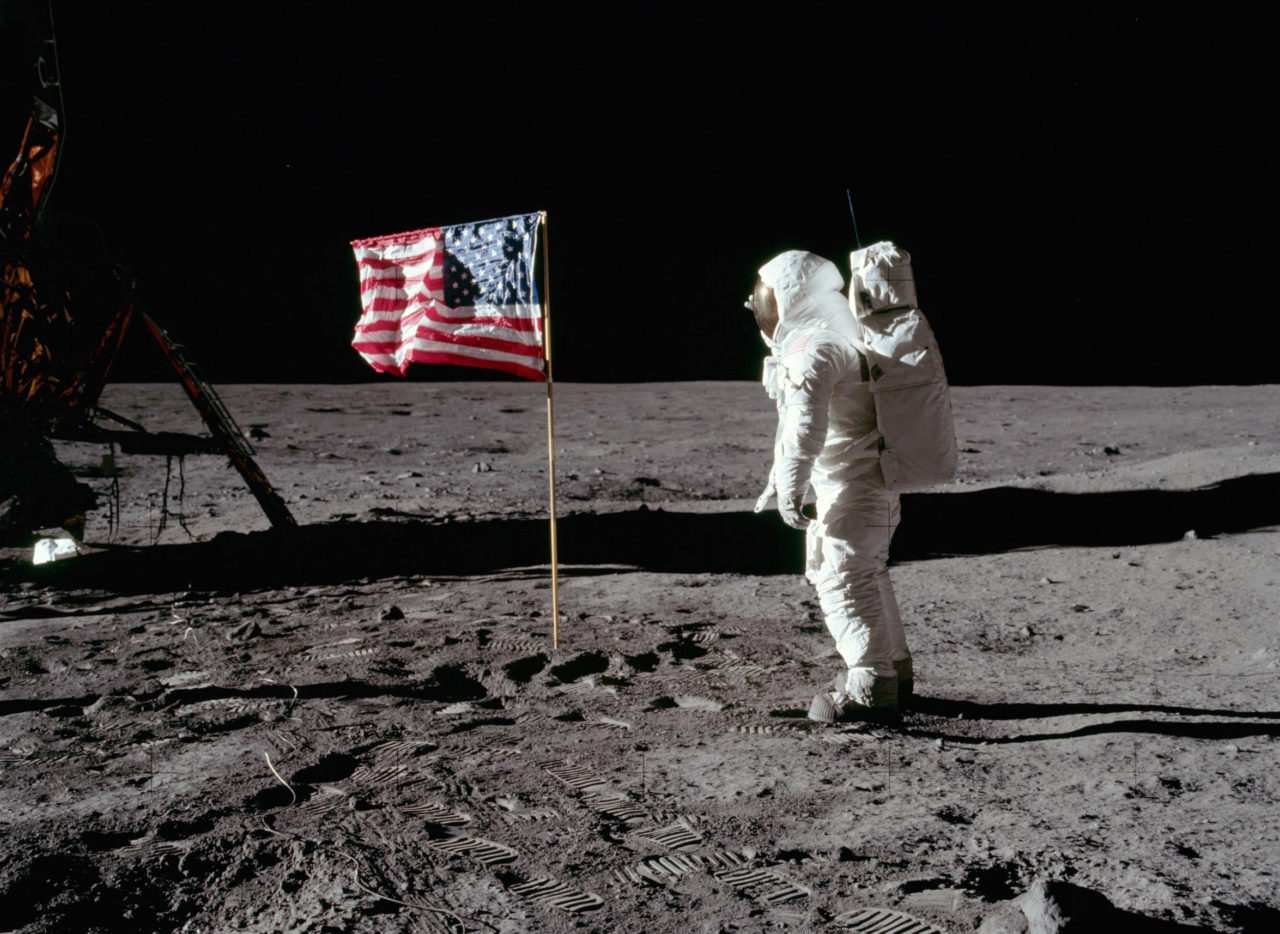
Astronaut Buzz Aldrin stands next to the deployed United States flag during the Apollo 11 lunar landing mission, 1969.
Indeed, even those of us who will never go to space should count ourselves as lucky to be alive at a time of renewed exploratory curiosity. That is, we are fortunate to be blessed with sturdy souls—in the public and private sectors—who are willing to take up the challenge of space-questing.
Tennyson’s Ulysses would have felt a kinship to all of these latter-day heroes.
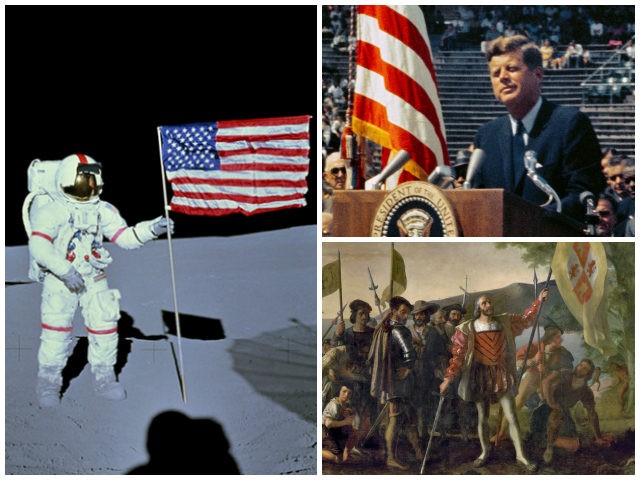
COMMENTS
Please let us know if you're having issues with commenting.